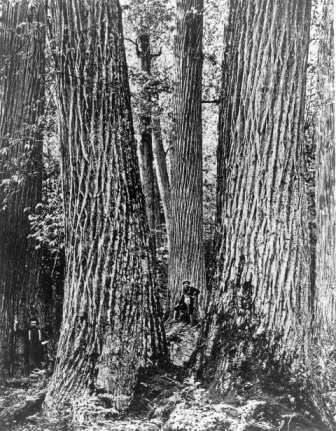 Once upon a time, the American chestnut was king.
Once upon a time, the American chestnut was king.
Some 100 years ago, this tree dominated the eastern forest from Maine to Georgia. It was the most numerous tree in the forest (one of every four hardwood trees was a chestnut). It was the biggest tree, sporting massive trunks up to 10 feet in diameter and reaching 100 feet high. And it was the most important tree, supporting every material need of humans and wildlife.
“At last when the tree can serve us no longer in any other way it forms the basic wood onto which oak and other woods are veneered to make our coffins,” said forester, P.L. Buttrick, in 1915 (Mighty Giants, p.67).
The American chestnut exemplified the cradle-to-grave concept, literally. So what makes this tree so useful?
- Its wood—strong, straight, and resistant to decay—was used to build everything from homes to furniture to fences, railroad ties, and barrels.
- Its tannin was extracted and used in the manufacture of leather and the dying of silk.
- Its blossoms, beloved by bees, produced the sweetest honey.
- Its highly nutritious and abundant nuts provided food for wildlife and people. Squirrels, bear, turkeys, and deer relied on nuts for food, and rural economies depended upon the nuts for fattening pigs, feeding families, and earning cash.
Blighted by Blight
Then one of the greatest natural disasters in forest history struck. In 1904, a devastating fungus was discovered on chestnut trees in New York’s Bronx Zoo. Within a few decades, the chestnut blight had killed over 4 billion chestnut trees on more than 200 million acres in eastern North America.
Today, you can still find chestnut trees in your local woods, but they are usually stumpy sprouts that rarely reach more than 10-20 feet high before succumbing to the blight. The roots of the tree continue to live and send out sprouts, but the tree will never grow tall and majestic like its ancestors.
A Path Forward
Thankfully, there is hope for the American chestnut. Last spring, Mass Audubon’s Wachusett Meadow Wildlife Sanctuary became a demonstration site for The American Chestnut Foundation’s (TACF) efforts to restore the American chestnut tree to our eastern woodlands.
By backcrossing the American chestnut with Asian chestnuts (which are naturally immune to the blight), the goal is to create an American chestnut that is blight-resistant but almost completely American, with all the strong qualities of the majestic trees of a century ago.
Wachusett Meadow’s demonstration orchard hosts five young seedlings, several generations into the breeding program. These five seedlings may not hold the key to the future in their DNA, but their presence will raise public awareness about the American chestnut and restoration efforts. Come see for yourself: An interpretative sign at the start of the South Meadow Trail points the way!
Want to learn more about the American chestnut?
- Visit the demonstration orchard at Wachusett Meadow Wildlife Sanctuary in Princeton.
- Check out The American Chestnut Foundation to find an orchard near you.
- Read Mighty Giants: An American Chestnut Anthology edited by Chris Bolgiano or American Chestnut: The Life, Death, and Rebirth of a Perfect Tree by Susan Freinkel.
Photo: American chestnut circa 1910 Courtesy of the Forest History Society


Joe here . I found a chesnut tree . It’s the only one that I know of . I live in Boylston ma and the tree is here as well . It doesn’t look healthy . There are no others near by so it’s not able to crosspolonate . I don’t know much about them . Maybe it can be saved . I’m not sure who to contact about help protecting / saving it . Thanks Joe Bounville [email protected] ?
What happens to the 10 -20 foot pieces that die off? Are they usable at all? I’m excited to hear that American Chestnut is trying to make a come back!
As a property owner with 4 American Chestnut trees still sending up the 10-20′ shoots, I read your article with interest. It is so sad to watch them grow and then die off.
The people working to restore the American chestnut are true visionaries, those who see the world as it once was, and as it will be again. This is not a short-term project, where one will see results within a lifetime, but pne rather requiring imagination – and faith! When the work started – 20 years ago or so? – some of the scientific advances such as DNA decoding were not even available. But it was so important that the work get started then, with what was at hand. That is a lesson I take from the work of the ACF.
Great article! Not too long but reat facts and figures. I have always wondered, based soley on furniture, how prevalent the AC was. Anyway to obtain seedlings by the general public for private plantings? Thanks
Hi Matthew — the only way to obtain seedlings that I’m aware of is to become a sponsor of The American Chestnut Foundation. Here’s the information on their website: http://www.acf.org/seeds_seedlings.php Good luck!
*Great article, Kristin! I really look forward to getting out to Wachusett Meadow and seeing the work that your sanctuary and TACF are doing to produce healthy American Chestnut strains. This coming March I will be giving a walk/talk on just this subject at Moose Hill, so this updated information will be of much assistance to me. Thank you!
Thank you, Michael, for your comments and for your love of the American chestnut. I would love to attend your class in March and will see if I can make it out to Moose Hill. Enjoy your visit to the Wachusett Meadow demonstration orchard!